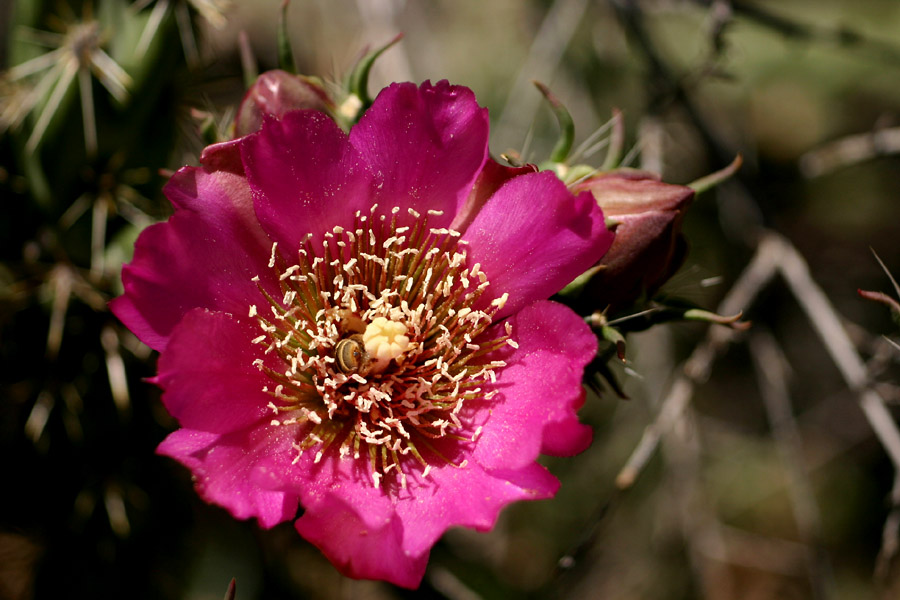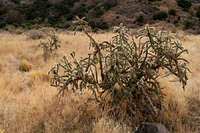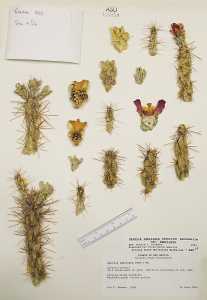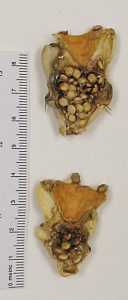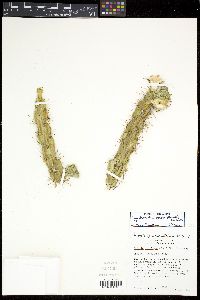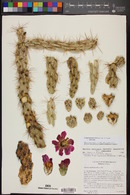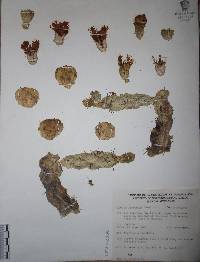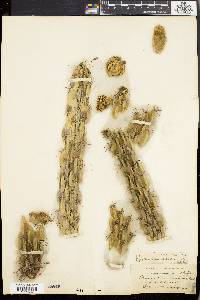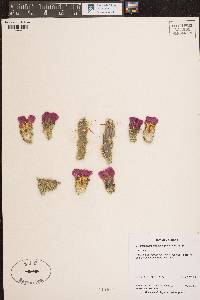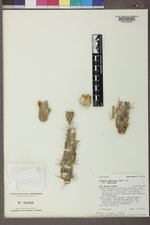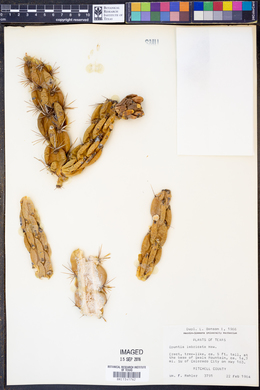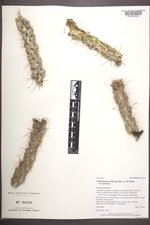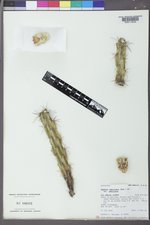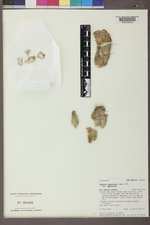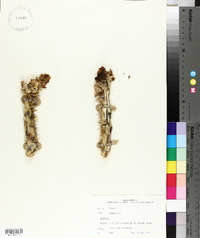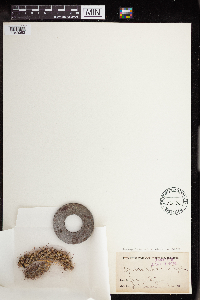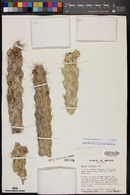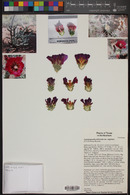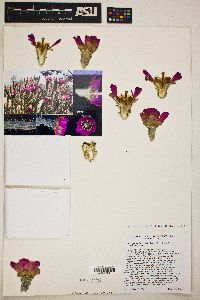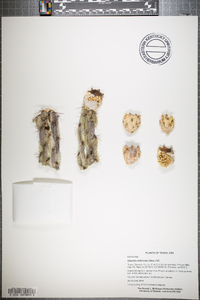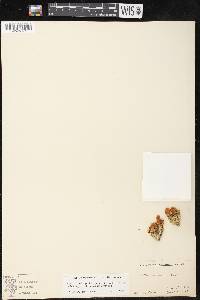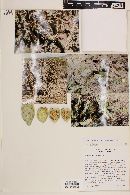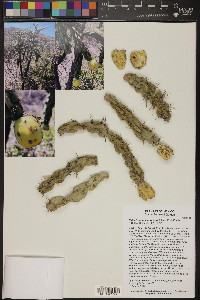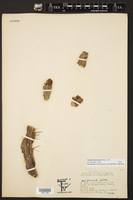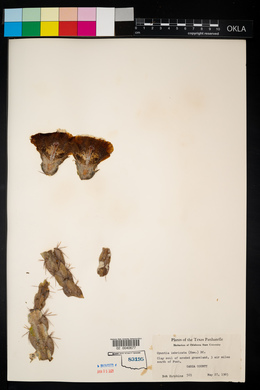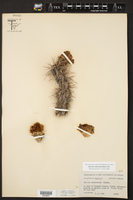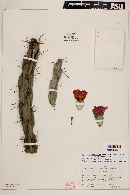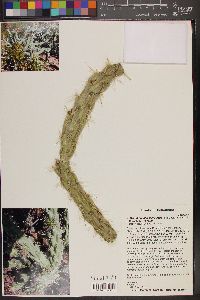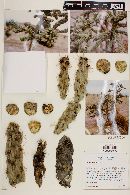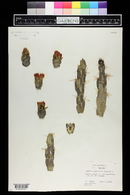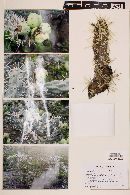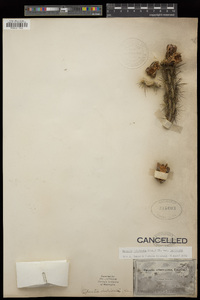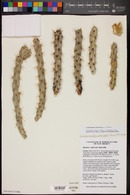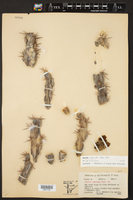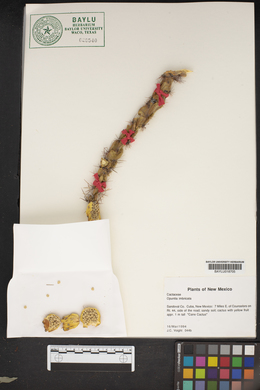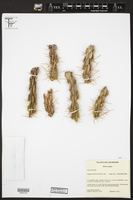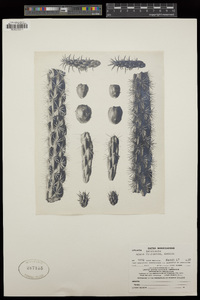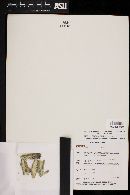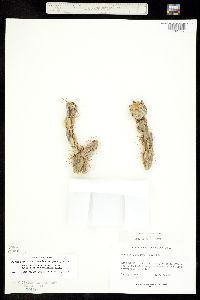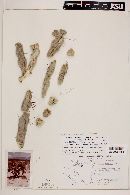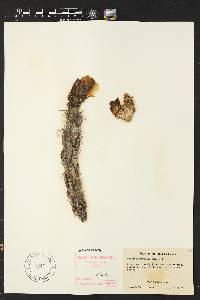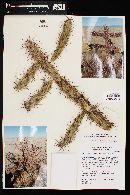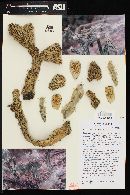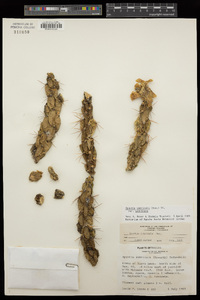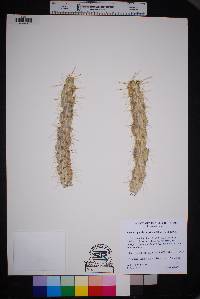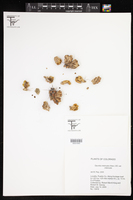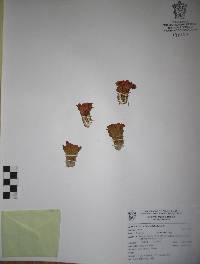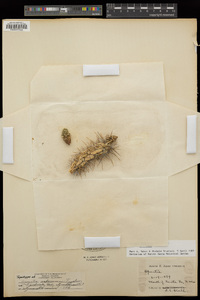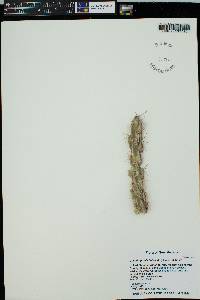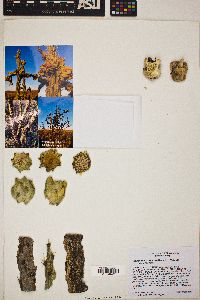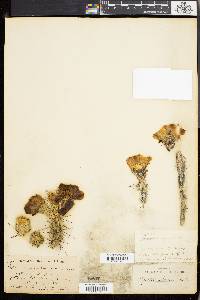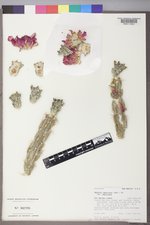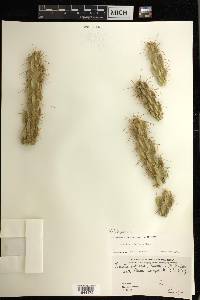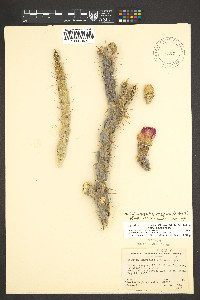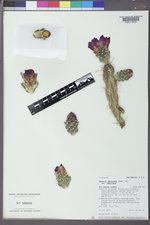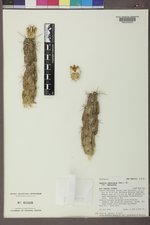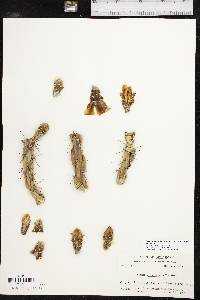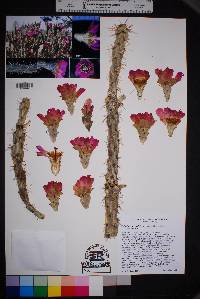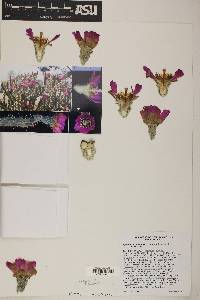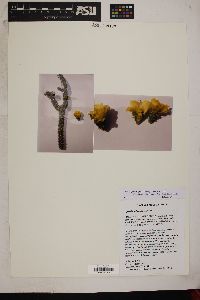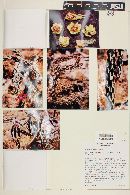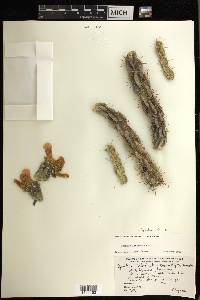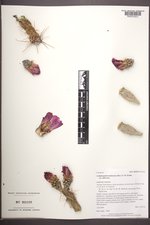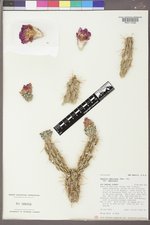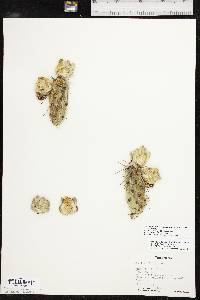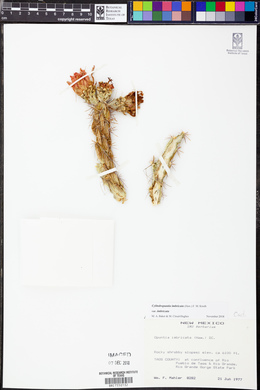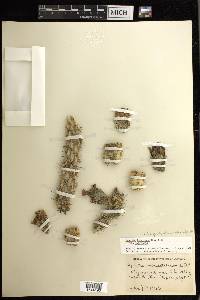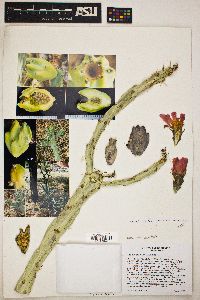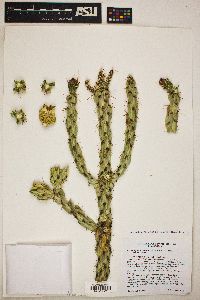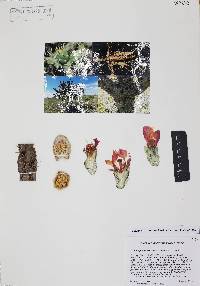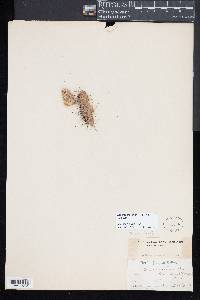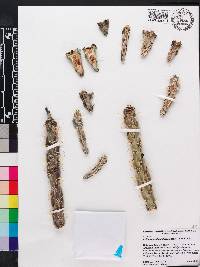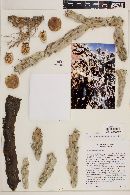
|
|
|
|
Family: Cactaceae
Tree Cholla, more...Cholla, walkingstick cholla
[Cylindropuntia lloydii (Rose) F.M. Knuth, moreOpuntia imbricata (Haw.) DC.] |
Trees, with short trunks, or large shrubs, widely branching, (1-)1.5-2.5(-5) m. Stem segments firmly attached, whorled or subwhorled, gray-green, cylindric to weakly clavate, 10-40 × 1.5-4 cm; tubercles very prominent, widely spaced, (1.5-)2-5 cm; areoles elliptic, 5-8 × 3-4 mm; wool yellow to tan, aging gray to black. Spines (5-)8-15(-30) per areole or spineless to nearly spineless, usually at most areoles, not obscuring stems, spreading, straight or slightly curved, silver to yellow to usually ± red or tan to brown, stout, terete or sometimes flattened basally, 8-30(-40) mm subequal; sheaths silver to yellow to usually tan to dirty white, yellow tipped. Glochids in dense adaxial tuft, pale yellow, 0.5-3 mm. Flowers: inner tepals dark pink to magenta to red-magenta, obovate, apiculate, 15-35 mm; filaments green basally to pink to magenta distally; anthers yellow; style light green basally or pink to red-magenta apically; stigma lobes green or cream. Fruits not proliferating, yellow, obovoid, 24-45 × 20-40 mm, fleshy, tuberculate, spineless; areoles 18-30; tubercles nearly equal in length or longer in proximal portion of fruit, prominent (occasionally smooth at maturity); umbilicus 7-14 mm deep. Seeds yellow-tan, subcircular to angled, warped, 2.5-4 mm diam., sides smooth to slightly lumpy; girdle usually narrow, not protruding. Plant: tree or shrub, (1-)1.5-2.5(-3) m tall; STEM segments gray-green, cylindric to weakly clavate, 8-25 cm long, 1.5-4 cm in diam.; tubercles very prominent, widely spaced, (1.5-)2-5 cm long. AREOLES yellow-tan-felty, aging gray to black, elliptic, 5-8 mm long, 3-4 mm wide Leaves: SPINES usually at most areoles, silver to yellow to usually reddish to tan to brown, not obscuring the stem, stout, terete or sometimes flattened basally, spreading, straight or slightly curved, (0-)8-15(-30) per areole, 8-30(-40) mm long; sheaths silver to yellow to usually tan to dirty-white, yellow-tipped. GLOCHIDS pale yellow, in dense apical tuft, 0.5-3 mm long Flowers: inner tepals dark pink to magenta to red-magenta, obovate, apiculate, 1.5-3.5 cm long; filaments green basally to pink to magenta apically, the anthers yellow; style light green basally to pink to red-magenta apically; stigmas green to cream Fruit: yellow, fleshy, obovoid, spineless, 2.4-4.5 cm long, 2-4 cm in diam., the tubercles subequal, prominent but occasionally smooth at maturity, the umbilicus 7-14 mm deep; areoles 18-30; SEEDS 2.5-4 mm diam., yellow-tan, subcircular to angled, warped, sides smooth to slightly lumpy, the girdle usually narrow, not protruding REFERENCES: Pinkava, Donald J. 1999. Cactaceae. Ariz. - Nev. Acad. Sci. 32(1). FNA 2004, Allred and Ivey 2012, Heil et al. 2013 Common Name: tree cholla Duration: Perennial General: Tree or shrub-sized cactus, 1-5 m tall; stems jointed and widely branching, with a whorled branching pattern (i.e. 3 or more branches emerge from a stem at one joint); stem segments firmly attached to each other, gray-green, cylinder shaped, 10-40 cm long and 1.5- 4 cm in diameter, with very prominent, widely spaced tubercles (tubercles are the regularly-spaced bumps along the stems; the tip of each tubercle has an areole with a cluster of spines emerging from it). Spines: Spines emerge from elliptic, woolly yellow or tan areoles which turn gray or black with age. Spines usually 8-15 per areole, 8-30 mm long, straight or slightly curved, stout and terete or a bit flattened near the base, the color ranging from silver, yellow, red, tan, or brown; spines at a given areole are of varying lengths and point in all different directions. Each spine has a yellow-tipped sheath, unless it fell off. Each areole also has a dense furry-looking tuft of pale yellow glochids (fine barbed bristles), 0.5-3 mm long. Flowers: Petals numerous, dark pink to red-magenta, obovate, 15-35 mm long, with a small pointed tip; stamens numerous, with filaments that are green near the base and pink near the tip, topped with yellow anthers; style light green near the base and pink to red-magenta near the tip; topped with a ring of green or cream-colored stigma lobes. Fruits: Fruits fleshy, yellow, spineless, obovoid, 2-5 cm long and 2-4 cm wide, with 18-30 tubercles and areoles; seeds round to angled, 2-4 mm wide, yellow-tan. Ecology: Found in deserts, grasslands, pinyon-juniper woodlands, hills, and plains, from 3,000-6,000 ft, rarely up to 7,500 ft (914-1829 m (-2286 m)); flowers May-August. Distribution: AZ, NM, TX, OK, KS, CO; south to ne MEX. Notes: FNA recognizes 2 varieties. The most common, var. imbricata, takes a tree-like growth form with plants 3-5 m tall, with 12-40 cm long stem segments, widely spaced tubercles, and tan to dirty white or yellowish spines. A dominant cholla of the Chihuahuan Desert, Cylindropuntia imbricata var. imbricata is wide- ranging and variable in several characters; it is generally shorter and more spiny northward, where the synonym Opuntia arborescens has been used. In Arizona, New Mexico, and Mexico, var. imbricata intergrades with C. spinosior. Northward, var. imbricata hybridizes with C. whipplei (with the resulting hybrids named C. ×viridiflora). The other recognized variety of this species, C. imbricata var. argentea, takes on a shrub-like growth form with plants up to 1.2 m tall, with 10-20 cm long stem segments, narrowly spaced tubercles, and silvery spines. Var. argentea is a narrow endemic of the Big Bend, TX area and species of conservation concern. It occurs in Chihuahuan desert scrub with lechuguilla and sotol, on rocky limestone slopes, flats, and ridges. Ethnobotany: Often used as an ornamental. The fleshy fruits were likely eaten. Etymology: Cylindropuntia comes from kylindros, for the cylinder-shaped stem segments, and the related genus Opuntia, from which this genus was segregated. Imbricata means tiled, probably referring to the pattern of the tubercles on the stem segments. Editor: AHazelton 2017 |
|
|
|
This project was made possible in part by the Institute of Museum and Library Services [MG-70-19-0057-19].
Powered by Symbiota

